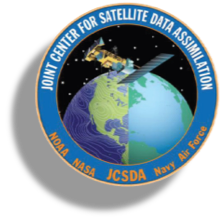On Thursday, July 13, the JCSDA core team and partners at NOAA, NASA, U.S. Navy and Air Force, and the UK Met Office met virtually and in-person to go over accomplishments from the last three months and discuss future goals. A lot of exciting progress towards operational deployment was made in this quarter and lots of functionality was added, from new sensors to big infrastructure improvements!
The Observations team kicked things off first thing in the morning. This quarter they:
Presented updated calibration for ATMS on NOAA 21
Demonstrated 4 new atmospheric sensors in Skylab v5 (COWVR, TEMPEST, SSMIS F17 and F18)
Updated UFO and FV3 JEDI to incorporate CRTM v3.0 for the sensors in Skylab
Worked with attendees at the UCAR-COSMIC symposium, where students used JEDI-Skylab in a multi-day practical. Onsite support was provided by JCSDA staff. At the end of the two week symposium the students presented their findings
Partners: NOAA EMC developed a python API interface for BUFR converters, which is a big win for that partner, and has accelerated development adding direct decoding for observation types such as aircraft, scatterometer winds, surface ships and surface meteorological stations. The U.S. Navy partner, NRL, has reached 90% observations with FALCON. The UK Met Office continued with acceptance trials, having completed and passed many already; the aircraft global trial is completed and the global surface meteorological station trial is underway. The UK Met Office also continues ongoing work to analyze the timings and resource usage to fit within their operational constraints
CRTM followed Observations, with equally exciting quarterly accomplishments including:
Merging v2.4.1 and v3.0.0 code
Releasing CRTM v3.0.0 as a demonstrator with Skylab v5
Implementing and successfully testing v3 in UFO and Skylab v5
Adding a new snow surface emissivity model from STAR with snow depth capability and grain size sensitivity, which will address some of the snow coverage issues in Skylab
Publishing a paper in BAMS, which you can read here
SOCA was next, with lots of developments in coupled DA over the last quarter:
Implemented a gridded sea level anomaly product with JEDI-based VAR in an outside collaboration with UMD and NESDIS/STAR, intended to go live later this year
Removed SOCA’s custom interpolation code to use an OOPS generic interpolation going forward: This is faster, more accurate, less code, and handles landmasking correctly
Developed an ocean color forward operator for OASIM in UFO that should be approved shortly
Found and fixed several bugs in the vertical gradient computation and balance operator
Partners: EMC has been running weakly coupled marine DA experiments, which are behaving well already
Atmospheric COMPOsition came in with some exciting new capabilities and accomplishments:
Cycling 3DVar with GEOS-CF, i.e. adding the forecast task with an actual GEOS-CF run
Added a new capability in EWOK variational task to write out increment files, which are later used in the geos-cf workflow (PR this quarter)
Added tracers to FV3-JEDI linear model, and are now just cleaning up the feature before issuing a PR
Created a new set of functions in IODA that can be called in UFO to get 2D data structures, which simplifies and condenses obs IODA file format of L2 retrievals and allows much more genericity for the column retrieval generator
Developed a simplified generic interface that uses atlas projections: The first application of this interface will be developing a benchmarking system of the JEDI Skylab system with other operational analysis and forecast products
Next up was Algorithms, with great progress in Skylab functionality and background error:
Generalized SABER blocks to allow for background error covariance training in a generic way
Added option for ensemble inflation in SABER blocks
Updated Skylab to add a 3D-FGAT option
Ran a live demo for GFS, MPAS and GFS-AERO Skylab at the JCSDA workshop
Partners: The UK Met Office developed a control-pert application which will soon be available in OOPS, with the PR in review now
Last but not least was Infrastructure:
Released spackstack 1.4.0 with NOAA-EMC and EPIC
Established experimental support for JEDI+NEPTUNE and full support for JEDI+FV3/UFS/MPAS/UM
Enabled automatic provisioning of users in cloud HPC environments on AWS (AWS Parallel Cluster)
Lowered build time for spack-stack environments
Stayed on target for R2D2 development and cloud infrastructure
Congratulations to the entire JCSDA staff and all of our partners and in-kinds for these big steps forward! Keep an eye out for upcoming developments with faster CI, advancements in UFS-atms cycling 3D FGAT, and much more.
If you have any questions or would like further information, you can visit us at https://jcsda.org/ or reach the team at jcsda-info@ucar.edu.

